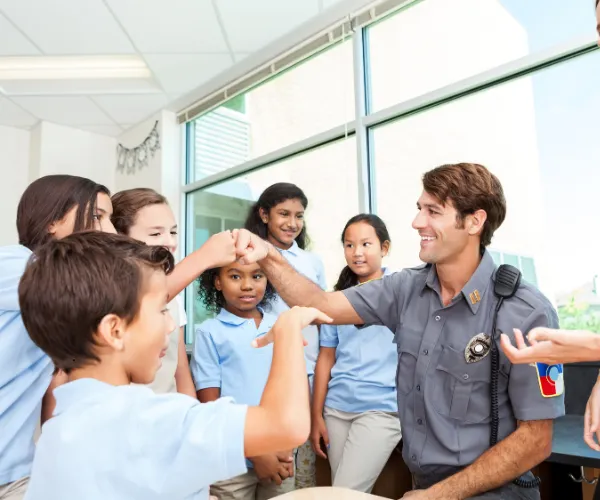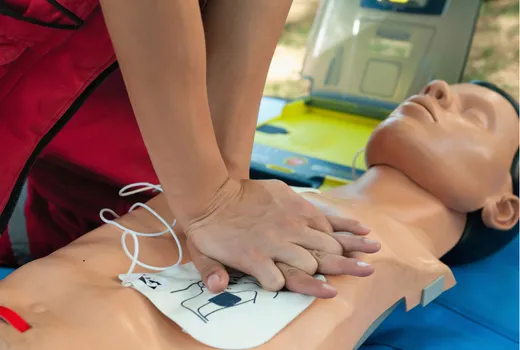Protecting Schools is Our Purpose!
Partnering With First Responders for Seamless Crisis Response

FSDAVCFEBFEVSDDVFSD

FSDAVCFEBFEVSDDVFSD

FSDAVCFEBFEVSDDVFSD
Coordinated Safety Through Strong Partnerships

Building Trust Before Emergencies Strike
Establishing strong relationships with first responders starts long before any incident. School leaders should schedule informal meetings with local police, fire, and EMS agencies. Campus tours and coffee chats allow responders to become familiar with school layouts, access points, daily routines, and leadership teams. These casual interactions build familiarity, mutual trust, and a shared sense of responsibility for student safety.
Make it a goal to identify key agency contacts and clarify who handles what during various emergency types. Share facility maps, discuss access routes, and confirm radio or communication preferences. Align emergency terminology—such as the difference between “lockout” and “lockdown”—to prevent confusion.
When everyone uses the same language and knows what to expect, response times shrink and chaos is minimized. This proactive groundwork ensures responders arrive informed and ready, even in the most high-pressure situations.

High-Income Collaboration Strategies
Real-time communication is critical. Schools should work with first responders to establish interoperable radios, shared digital alert systems, or secured group messaging apps. Granting key-card access to officers and fire personnel allows them to move quickly through buildings during lockdowns, medical emergencies, or drills. These small steps help eliminate delays and support faster, safer decision-making. Including a school resource officer or designated emergency liaison in routine meetings ensures responders stay updated on changing protocols and building layouts.
First responders should not be viewed as outsiders who arrive only during a crisis. Including them in monthly safety meetings and tabletop exercises fosters familiarity and operational consistency. Their input on physical security assessments and emergency response planning adds real-world expertise that schools can’t afford to overlook. When agencies use the same incident-command software, they respond as a coordinated unit rather than separate entities.
The impact of collaboration is clear. Schools that integrate emergency agencies into their safety planning often report faster response times, clearer division of responsibilities during crises, and smoother evacuations or reunifications. These improvements aren’t theoretical—they show up in drills, incident logs, and post-event reviews. Early involvement builds confidence that everyone knows their role before an emergency begins.
Formalizing Roles With Clear MOUs

A written agreement strengthens collaboration between schools and emergency responders. A clear memorandum of understanding (MOU) defines each agency’s role during various incidents. It includes who takes command, communication channels, response timelines, and participation in training or drills. MOUs help eliminate guesswork during high-stress moments by setting shared expectations early and in writing.
Keep MOUs simple, direct, and legally reviewed. They should avoid vague language and clearly outline who is responsible for what. Privacy issues—like access to student information—should be addressed directly. A clear, readable agreement helps avoid confusion during a crisis and builds trust between agencies.
MOUs shouldn’t be static or forgotten.
Annual reviews ensure they reflect current threats, staffing changes, or building modifications. Each year, both school leaders and emergency partners should review and sign updated versions to maintain accountability and coordination going forward.
A written agreement strengthens collaboration between schools and emergency responders. A clear memorandum of understanding (MOU) defines each agency’s role during various incidents. It includes who takes command, communication channels, response timelines, and participation in training or drills. MOUs help eliminate guesswork during high-stress moments by setting shared expectations early and in writing.
Keep MOUs simple, direct, and legally reviewed. They should avoid vague language and clearly outline who is responsible for what. Privacy issues—like access to student information—should be addressed directly. A clear, readable agreement helps avoid confusion during a crisis and builds trust between agencies.
MOUs shouldn’t be static or forgotten.
Annual reviews ensure they reflect current threats, staffing changes, or building modifications. Each year, both school leaders and emergency partners should review and sign updated versions to maintain accountability and coordination going forward.

Start by drafting a basic outline and collecting input from local agency leads. Keep the language clear and specific, focusing on roles, communication, and joint response expectations. Assign a lead writer—usually someone from the district’s safety or legal team—to consolidate feedback and track revisions. Once the core structure is in place, submit the draft to the district’s legal counsel for formal review. After incorporating changes, schedule follow-up meetings to finalize the content and secure buy-in from all agencies involved.
Include school board members and responder representatives in the final discussions to reinforce shared ownership. Once the agreement is adopted, create a parent-facing summary. This version should explain what the MOU covers, why it matters, and how it helps protect students. Publishing this summary on the school website or in safety newsletters builds public confidence. It shows the school takes preparedness seriously and works hand-in-hand with first responders to stay ready.
Coordinated Drills and Joint Exercises
Routine drills are important, but joint drills bring real preparedness to the next level. Schedule multi-agency exercises that simulate real-world emergencies like lockdowns, building evacuations, and medical triage scenarios. Run the drills using actual class schedules and entry protocols, testing every door, hallway, and alarm system. Allow teachers and students to respond as they would during a true event—without prior warning or scripted responses. The goal is realism, not perfection.
After the drill, hold a unified after-action review. Bring school staff, police, fire, and EMS personnel into the same room to discuss observations. Ask what slowed response times, which communication gaps emerged, and where confusion occurred. Assign clear corrective actions with deadlines and responsible parties. Record everything—these documented steps not only strengthen school safety plans but also help fulfill federal and state reporting requirements.
Performance metrics offer valuable insight. Track how long it takes to reach a lockdown status, how quickly EMS reaches a simulated patient, and how clearly instructions are transmitted via radio. Use this data to measure progress over time. Improved numbers often lead to fewer missteps, better coordination, and stronger justification when applying for future safety-related funding or policy changes from the district.
Training Staff and Students Together
Low-cost training goes further when responders join the effort. Many fire departments offer free or low-cost Stop-the-Bleed workshops. EMS agencies often co-host CPR certification drives on campus. Police departments can lead age-appropriate school assemblies that teach safety practices without creating fear or anxiety among students.
These joint sessions help build mutual trust and practical familiarity. Teachers and staff get the chance to ask questions, and students learn directly from the professionals who will show up during an emergency. Responders, in turn, gain valuable insight into school routines, hallway layouts, and entry procedures—making future responses faster and more effective.
Most of all, shared training gives school staff confidence. When a nurse, coach, or teacher has practiced a scenario with EMS responders, they’re more likely to act quickly and correctly in those first critical moments before outside help arrives.

Set a quarterly training calendar and rotate focus areas—CPR, intruder drills, reunification prep, or shelter-in-place protocols. Include both staff and students whenever appropriate. Coordinate with local first responders to co-lead sessions and provide realistic context. After each session, send short surveys to participants—students, teachers, and responders—asking what felt clear, what was confusing, and what could be improved. This feedback loop helps refine future sessions and ensures that drills remain effective and relevant without requiring additional resources.
Recognize wins publicly to boost morale and participation. If a student correctly uses an AED during a simulation or a teacher follows the emergency protocol with precision, thank them during morning announcements or in the school newsletter. These moments reinforce that readiness is valued and achievable. Public praise fosters a culture where safety is everyone’s responsibility, and success becomes contagious. It encourages others to take drills seriously and reinforces a shared commitment to safety.
Sustaining Partnerships Year After Year
Strong partnerships can fade without regular attention. To keep relationships active, rotate liaison roles between school staff and first responder agencies every year or two. This approach reduces burnout and introduces new ideas into safety planning. It also keeps communication fresh and builds broader familiarity between school personnel and responders.
Share monthly safety updates with agency partners, even if no major incidents occurred. Simple data points—like false alarms, maintenance issues, or minor policy changes—help responders stay in sync with evolving campus routines. Invite them to participate in staff meetings, early dismissal drills, or debriefs after real events. These collaborative sessions strengthen working relationships and uncover small gaps that might otherwise go unnoticed.
Make room for celebration, too. Recognize National First Responders Day on campus with thank-you breakfasts, bulletin board shout-outs, or student-made cards. Include partnership outcomes in school board updates and grant applications. Highlight metrics such as reduced emergency response times, more effective evacuations, or improved staff communication. When partnerships are visible and documented, stakeholders see the value and are more likely to support future initiatives. These relationships aren’t just symbolic—they actively protect students and staff in moments that matter most. Keep them strong through transparency, appreciation, and shared purpose.
Have Questions About What We Offer?
To learn more about our services, contact us today!
Have Questions About What We Offer?
Contact us to learn more about our services
Quick Links
Hours of Operation
Mon - Fri | 9:00 AM - 5:00 PM
Sat - Sun | Closed

©2025 American Priority Project | All Rights Reserved | Privacy Policy

